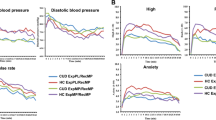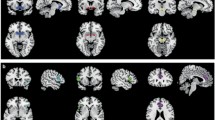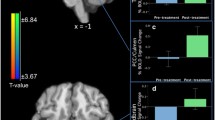Abstract
Rationale
Stimulant drugs like methamphetamine (MA) activate brain reward circuitry, which is linked to the development of problematic drug use. It is not clear how drugs like MA alter neural response to a non-drug reward.
Objectives
We examined how acute MA impacts neural response to receipt of a monetary reward relative to a loss in healthy adults. We hypothesized that MA (vs. placebo) would increase mesolimbic neural activation to reward, relative to loss.
Methods
In a within-subject, randomized, cross-over, double-blind, placebo-controlled design, 41 healthy adults completed the Doors monetary reward task during fMRI after ingestion of placebo or 20 mg MA. We examined drug effects on neural response to reward receipt (Win vs. Loss) using a priori anatomical striatal regions of interest (nucleus accumbens (NAcc), caudate, putamen).
Results
MA decreased NAcc BOLD activation to reward vs loss compared to placebo (p=.007) without altering caudate or putamen BOLD activation. Similar effects for reward vs. loss were obtained using whole brain analysis. Additional exploratory ROI analysis comparing reward and loss activation relative to a neutral “fixation” period indicated that MA increased NAcc BOLD activation during loss trials, without decreasing activation during win trials.
Conclusions
This preliminary evidence suggests that MA increases NAcc neural response to the receipt of monetary loss. Additional studies are needed to replicate our findings and clarify the mechanisms contributing to altered mesolimbic neural response to reward and loss receipt during stimulant intoxication.




Similar content being viewed by others
References
Abi-Dargham A, Kegeles LS, Martinez D, Innis RB, Laruelle M (2003) Dopamine mediation of positive reinforcing effects of amphetamine in stimulant naive healthy volunteers: results from a large cohort. Eur Neuropsychopharmacol 13:459–468
Andersson JL, Skare S, Ashburner J (2003) How to correct susceptibility distortions in spin-echo echo-planar images: application to diffusion tensor imaging. Neuroimage 20:870–888
Bjork JM, Chen G, Smith AR, Hommer DW (2010) Incentive-elicited mesolimbic activation and externalizing symptomatology in adolescents. J Child Psychol Psychiatry 51:827–837
Brislin SJ, Weigard AS, Hardee JE, Cope LM, Martz ME, Zucker RA, Heitzeg MM (2022) Sex moderates reward- and loss-related neural correlates of triarchic-model traits and antisocial behavior. Clin Psychol Sci 10:700–713
Cao Z, Bennett M, Orr C, Icke I, Banaschewski T, Barker GJ, Bokde AL, Bromberg U, Büchel C, Quinlan EB, Desrivières S (2019) Mapping adolescent reward anticipation, receipt, and prediction error during the monetary incentive delay task. Hum Brain Mapp 40:262–283
Carlson JM, Foti D, Mujica-Parodi LR, Harmon-Jones E, Hajcak G (2011) Ventral striatal and medial prefrontal BOLD activation is correlated with reward-related electrocortical activity: a combined ERP and fMRI study. Neuroimage 57:1608–1616
Cox RW (1996) AFNI: software for analysis and visualization of functional magnetic resonance neuroimages. Comput Biomed Res 29:162–73. https://doi.org/10.1006/cbmr.1996.0014
Crane NA, Gorka SM, Weafer J, Langenecker SA, de Wit H, Phan KL (2018) Neural activation to monetary reward is associated with amphetamine reward sensitivity. Neuropsychopharmacology 43:1738–1744
de Wit H, Phillips TJ (2012) Do initial responses to drugs predict future use or abuse? Neurosci Biobehav Rev 36:1565–1576
Delgado MR, Nystrom LE, Fissell C, Noll DC, Fiez JA (2000) Tracking the hemodynamic responses to reward and punishment in the striatum. J Neurophysiol 84:3072–3077
Drevets WC, Gautier C, Price JC, Kupfer DJ, Kinahan PE, Grace AA, Price JL, Mathis CA (2001) Amphetamine-induced dopamine release in human ventral striatum correlates with euphoria. Biol Psychiatry 49:81–96
Fischman MW, Foltin RW (1991) Utility of subjective-effects measurements in assessing abuse liability of drugs in humans. Br J Addict 86:1563–1570
Forbes EE, Rodriguez EE, Musselman S, Narendran R (2014) Prefrontal response and frontostriatal functional connectivity to monetary reward in abstinent alcohol-dependent young adults. PloS One 9:e94640
Foti D, Hajcak G (2009) Depression and reduced sensitivity to non-rewards versus rewards: evidence from event-related potentials. Biol Psychol 81:1–8
Foti D, Weinberg A, Dien J, Hajcak G (2011) Event-related potential activity in the basal ganglia differentiates rewards from nonrewards: temporospatial principal components analysis and source localization of the feedback negativity. Hum Brain Mapp 32:2207–2216
Guerin AA, Kim JH (2021) Age of onset and its related factors in cocaine or methamphetamine use in adults from the United States: results from NHANES 2005-2018. Int J Environ Res Public Health 18(22):12259
Haber SN, Knutson B (2010) The reward circuit: linking primate anatomy and human imaging. Neuropsychopharmacology 35:4–26
Hajcak G, Moser JS, Holroyd CB, Simons RF (2006) The feedback-related negativity reflects the binary evaluation of good versus bad outcomes. Biol Psychol 71:148–154
Han B, Compton WM, Jones CM, Einstein EB, Volkow ND (2021) Methamphetamine use, methamphetamine use disorder, and associated overdose deaths among US adults. JAMA Psychiatry 78:1329–1342
Heitzeg MM, Cope LM, Martz ME, Hardee JE (2015) Neuroimaging risk markers for substance abuse: recent findings on inhibitory control and reward system functioning. Curr Addict Rep 2:91–103
Ivanov I, Liu X, Shulz K, Fan J, London E, Friston K, Halperin JM, Newcorn JH (2012) Parental substance abuse and function of the motivation and behavioral inhibition systems in drug-naive youth. Psychiatry Res 201:128–135
Johanson CE, Uhlenhuth EH (1980) Drug preference and mood in humans: d-amphetamine. Psychopharmacology 71:275–279
Knutson B, Bjork JM, Fong GW, Hommer D, Mattay VS, Weinberger DR (2004) Amphetamine modulates human incentive processing. Neuron 43:261–269
Koob GF, Volkow ND (2016) Neurobiology of addiction: a neurocircuitry analysis. Lancet Psychiatry 3:760–773
Langenecker SA, Kling LR, Crane NA, Gorka SM, Nusslock R, Damme KSF, Weafer J, de Wit H, Phan KL (2020) Anticipation of monetary reward in amygdala, insula, caudate are predictors of pleasure sensitivity to d-Amphetamine administration. Drug Alcohol Depend 206:107725
Leyton M, Boileau I, Benkelfat C, Diksic M, Baker G, Dagher A (2002) Amphetamine-induced increases in extracellular dopamine, drug wanting, and novelty seeking: a PET/[11C] raclopride study in healthy men. Neuropsychopharmacology 27:1027–1035
Luijten M, Schellekens AF, Kuhn S, Machielse MW, Sescousse G (2017) Disruption of reward processing in addiction : an image-based meta-analysis of functional magnetic resonance imaging studies. JAMA Psychiatry 74(4):387–398
Manza P, Shokri-Kojori E, Wiers CE, Kroll D, Feldman D, McPherson K, Biesecker E, Dennis E, Johnson A, Kelleher A, Qu S, Tomasi D, Wang GJ, Volkow ND (2022) Sex differences in methylphenidate-induced dopamine increases in ventral striatum. Mol Psychiatry 27:939–946
Marshall BD, Galea S, Wood E, Kerr T (2011) Injection methamphetamine use is associated with an increased risk of attempted suicide: a prospective cohort study. Drug Alcohol Depend 119:134–137
Martin WR, Sloan JW, Sapira JD, Jasinski DR (1971) Physiologic, subjective, and behavioral effects of amphetamine, methamphetamine, ephedrine, phenmetrazine, and methylphenidate in man. Clin Pharmacol Ther 12:245–258
Martinez D, Slifstein M, Broft A, Mawlawi O, Hwang DR, Huang Y, Cooper T, Kegeles L, Zarahn E, Abi-Dargham A, Haber SN, Laruelle M (2003) Imaging human mesolimbic dopamine transmission with positron emission tomography. Part II: amphetamine-induced dopamine release in the functional subdivisions of the striatum. J Cereb Blood Flow Metab 23:285–300
Mayo LM, de Wit H (2015) Acquisition of responses to a methamphetamine-associated cue in healthy humans: self-report, behavioral, and psychophysiological measures. Neuropsychopharmacology 40:1734–1741
Miller EM, Shankar MU, Knutson B, McClure SM (2014) Dissociating motivation from reward in human striatal activity. J Cogn Neurosci 26:1075–1084
NIDA (2017) Trends & Statistics. https://www.drugabuse.gov/related-topics/trends-statistics. Accessed 11 Nov 2022
NIDA (2019) Methamphetamine research report. https://nida.nih.gov/publications/research-reports/methamphetamine/what-are-long-term-effects-methamphetamine-misuse. Accessed 11 Nov 2022
O’Daly OG, Joyce D, Tracy DK, Azim A, Stephan KE, Murray RM, Shergill SS (2014) Amphetamine sensitization alters reward processing in the human striatum and amygdala. PloS One 9:e93955
Oswald LM, Wong DF, McCaul M, Zhou Y, Kuwabara H, Choi L, Brasic J, Wand GS (2005) Relationships among ventral striatal dopamine release, cortisol secretion, and subjective responses to amphetamine. Neuropsychopharmacology 30:821–832
Proudfit GH (2015) The reward positivity: from basic research on reward to a biomarker for depression. Psychophysiology 52:449–459
Radoman M, Crane NA, Gorka SM, Weafer J, Langenecker SA, de Wit H, Phan KL (2021) Striatal activation to monetary reward is associated with alcohol reward sensitivity. Neuropsychopharmacology 46:343–350
Redish AD (2004) Addiction as a computational process gone awry. Science 306:1944–1947
Robbins TW, Cador M, Taylor JR, Everitt BJ (1989) Limbic-striatal interactions in reward-related processes. Neurosci Biobehav Rev 13:155–162
Rolls ET, Huang CC, Lin CP, Feng J, Joliot M (2020) Automated anatomical labelling atlas 3. Neuroimage 206:116189
Smith SM, Jenkinson M, Woolrich MW, Beckmann CF, Behrens TE, Johansen-Berg H, Bannister PR, De Luca M, Drobnjak I, Flitney DE, Niazy RK, Saunders J, Vickers J, Zhang Y, De Stefano N, Brady JM, Matthews PM (2004) Advances in functional and structural MR image analysis and implementation as FSL. Neuroimage 23(Suppl 1):S208–S219
Stice E, Yokum S (2014) Brain reward region responsivity of adolescents with and without parental substance use disorders. Psychol Addict Behav 28:805–815
Stice E, Yokum S, Burger KS (2013) Elevated reward region responsivity predicts future substance use onset but not overweight/obesity onset. Biol Psychiatry 73:869–876
Volkow ND, Fowler JS, Wang GJ, Ding YS, Gatley SJ (2002) Role of dopamine in the therapeutic and reinforcing effects of methylphenidate in humans: results from imaging studies. Eur Neuropsychopharmacol 12:557–566
Webber HE, Lopez-Gamundi P, Stamatovich SN, de Wit H, Wardle MC (2021) Using pharmacological manipulations to study the role of dopamine in human reward functioning: A review of studies in healthy adults. Neurosci Biobehav Rev 120:123–158
White TL, Justice AJ, de Wit H (2002) Differential subjective effects of D-amphetamine by gender, hormone levels and menstrual cycle phase. Pharmacol Biochem Behav 73:729–741
Woodcock EA, Zakiniaeiz Y, Morris ED, Cosgrove KP (2020) Sex and the dopaminergic system: Insights from addiction studies. Handb Clin Neurol 175:141–165
Disclaimer
The contents of the paper are solely the responsibility of the authors and do not necessarily represent the official views of NIDA, NIGMS, or the National Institutes of Health.
Funding
This publication was funded by the National Institute on Drug Abuse (NIDA) (R01DA002812, PI: HdW). NAC was supported by NIDA (K23DA048132, PI: NAC). HM was supported by the National Institute of General Medical Sciences (NIGMS) (T32GM07019). Dr. de Wit has served on Scientific Advisory committees for Gilgamesh Pharmaceuticals, Awakn Life Sciences and MIND Foundation, and she is on the Board of Directors of PharmAla Biotech.
Author information
Authors and Affiliations
Contributions
All authors have participated sufficiently in the work and take responsibility for authorship and publication. NAC conducted the statistical analyses, interpreted the data, and wrote the initial draft of the paper. HM made substantial contributions to the data analysis and writing of the manuscript. HDW was the principal investigator of the study, contributed to the conceptual design of the study, made important contributions to the editing of the paper, and assisted in data interpretation.
Corresponding author
Ethics declarations
Conflict of interest
The authors declare no competing interests.
Additional information
Publisher’s note
Springer Nature remains neutral with regard to jurisdictional claims in published maps and institutional affiliations.
Supplementary information
Rights and permissions
Springer Nature or its licensor (e.g. a society or other partner) holds exclusive rights to this article under a publishing agreement with the author(s) or other rightsholder(s); author self-archiving of the accepted manuscript version of this article is solely governed by the terms of such publishing agreement and applicable law.
About this article
Cite this article
Crane, N.A., Molla, H. & de Wit, H. Methamphetamine alters nucleus accumbens neural activation to monetary loss in healthy young adults. Psychopharmacology 240, 1891–1900 (2023). https://doi.org/10.1007/s00213-023-06398-4
Received:
Accepted:
Published:
Issue Date:
DOI: https://doi.org/10.1007/s00213-023-06398-4




